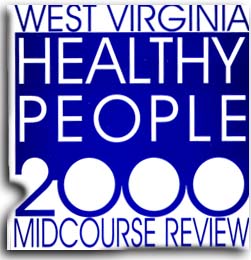 |
Heart Disease and Stroke |
 |
Heart Disease and Stroke |
Background
Heart disease continues to be the leading cause of death in both the United States and West Virginia, while strokes continue as the third leading cause of death. Deaths due to both heart disease and stroke are decreasing in West Virginia, as they are in the United States as a whole; however, state deaths are declining at a slower rate than those in the nation as a whole. The prevalence of hypertension, a leading cardiovascular disease risk factor, has declined only slightly since reporting began in 1984 through the Behavioral Risk Factor Surveillance System (BRFSS).
Premature death from heart disease, stroke, or other hypertension-related illnesses is tragic because it is potentially preventable. The health of the cardiovascular system can be maintained by choosing healthy lifestyle behaviors, particularly in the areas of physical activity, nutrition, and smoking. The rates of sedentary lifestyle, cigarette smoking, and dietary fat consumption are all too high in West Virginia, producing an environment that is not conducive to the prevention of cardiovascular disease.
The WV Cardiovascular Disease Program, with the newly formed Cardiovascular Disease Prevention Partners, will develop a plan to address the problem of cardiovascular disease.
At the present rate of decline, the year 2000 rate of heart disease mortality is forecast to be 267.2 deaths per 100,000 population.
The Objectives
OBJECTIVE 15.1 Reduce deaths due to diseases of the heart to no more than 300 per 100,000 population.
UPDATE The 1995 age-adjusted rate of heart disease mortality was 308.3 deaths per 100,000 population (adjusted to the 1990 U.S. population distribution), compared to 428.7 in 1980 and 335.2 in 1990 (see Figure 1). This decline, which has occurred on both the national and state levels, has been the result of positive changes in personal behaviors such as cigarette smoking and nutrition, as well as improvements in medical care and technology.
OBJECTIVE 15.2 Reduce deaths due to cerebrovascular disease to no more than 20 per 100,000 population.
UPDATE Stroke deaths have also been on the decline in both the state and the nation. Since 1980, the rate of stroke mortality (adjusted to the 1940 U.S. population distribution to be comparable to the U.S. rates) has decreased 39.4%, from 45.4 deaths per 100,000 in 1980 to 27.5 in 1995 (see Figure 2). The year 2000 rate is projected to be 25.4 deaths per 100,000, 27.0% higher than the target rate of 20.0.
OBJECTIVE 15.3 Reduce the rate of hypertension awareness among adult West Virginians to 15%.
UPDATE Hypertension awareness prevalence is a measure of the proportion of those respondents who answered "yes" to the Behavioral Risk Factor Survey question "Have you ever been told by a doctor, nurse, or other health professional that you have high blood pressure?"
The overall rate of hypertension awareness has decreased slightly since BRFSS monitoring began, from a baseline prevalence of 28.6% reported in 1984 to a rate of 25.5% in 1995 (see Figure 3). If the present rate of decline continues, the year 2000 prevalence is estimated to be 23.8%, still much higher than the target rate of 15%.
Meeting the Objectives
Health Promotion
Channels Worksites |
On February 1, 1995, a national plan was unveiled to assist states in reaching the Healthy People Year 2000 objectives regarding cardiovascular disease prevention and control. The plan issued a mandate to all states: "To improve the cardiovascular health of all Americans, every state health department will have the commitment, capacity, and resources to implement comprehensive cardiovascular disease prevention and control programs." In response to the mandate, the Cardiovascular Disease Prevention Partners (CDPP) was formed to develop a plan to reduce and prevent cardiovascular disease in West Virginia. The goals of the group are to (1) raise awareness of the problem of cardiovascular disease in the state; (2) support, change, and maintain health promotion behaviors; and (3) encourage personal and public responsibility for good health. The Program Manager of the Cardiovascular Disease Program, Division of Health Promotion, WV Bureau for Public Health, is the contact person for plan development and implementation.
The Cardiovascular Disease Prevention Partners represents a collaborative effort between the programs, coalitions, and other organizations throughout the state that address cardiovascular disease. The group first met in May 1996 to begin developing a strategic plan for the prevention and control of cardiovascular disease.
The following organizations and coalitions are currently represented in CDPP:
Coalition for a Tobacco-Free WV
WV Diabetes Coalition
WV Nutrition and Chronic Disease Coalition
WV Coalition for Physical Activity
WVU Prevention Research Center
WVU School of Medicine
Marshall University School of Medicine
WV Osteopathic School of Medicine
American Heart Association (WV Affiliate)
WV Bureau for Public Health
CDPP is developing a manual for local community use that will provide guidance in developing strategies for the risk factors associated with heart disease and stroke, specifically tobacco use, physical inactivity, and nutrition. The action plans will utilize the health promotion channels to the community found in the box to the left and discussed in detail in the Introduction. Working together will allow the member groups to share resources and data to more effectively combat the significant problem of cardiovascular disease in West Virginia.
Heart Disease and Stroke - Meeting the Objectives
Lead Entities:
WV Cardiovascular Disease Program
Cardiovascular Disease Prevention Partners
Plan Coordinator:
Jessica Wright, Program Manager
Cardiovascular Disease Program
Division of Health Promotion
WV Bureau for Public Health
(304) 558-0644/FAX (304) 558-1553